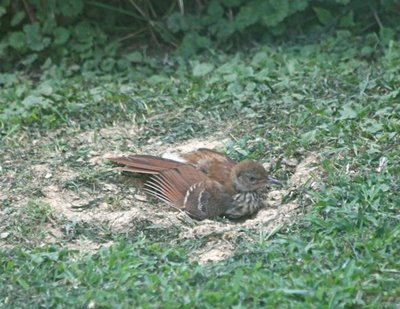
Dust bathing helps birds control parasites such as feather mites and lice. Dust particles get under the scutes of mites and lice, causing the parasites such discomfort that they drop off. It's the same principle that makes dolomitic earth (derived from the silicon-based skeletons of microscopic sea creatures) such an effective pest control. Why use poisons when an irritant will do the job? Both dust and dolomitic earth are non-toxic.
I've noticed that certain bird species are really into dust bathing. Wild turkeys, ruffed grouse (indeed, all the gallinaceous birds); house sparrows, chipping sparrows and brown thrashers are the big dust bathers in our yard. I'm delighted when a dust bath develops within sight of a window, as it has this year.
Brown thrashers have been the instigators in creating a dust bowl in our side yard. We have a family of recently-fledged thrashers in the yard, and we see them dust bathing several times a day. I took these pictures through a double-paned window, so they're no great shakes, but they're amusing anyway.
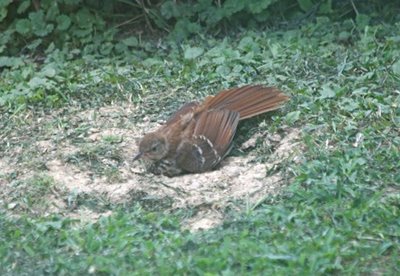
A dust bathing bird goes through the same ritualistic motions that it does when it's in water--dipping the head, scrubbing the breast around, and ruffling its wings so as to send the bathing medium, be it dust or water, through the plumage.
It turns and wallows in circles.
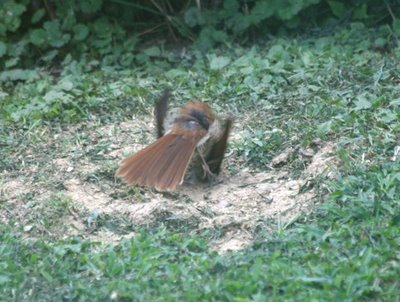
This thrasher, having completed its toilette, did something I found very interesting. It zeroed in on a couple of large chunks of dry clay and, with a few strikes of its strong bill, pulverized them, creating more dust for the bath.
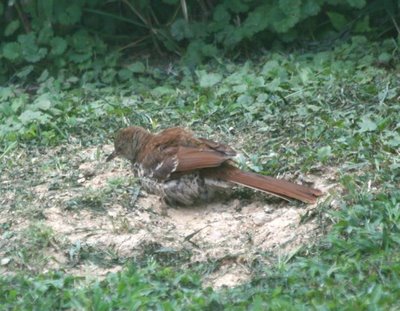 Here, it is pecking a clod into pieces.
Here, it is pecking a clod into pieces.To me, this behavior--seeking out and pulverizing clods of dirt-- suggests that the thrasher realizes that, in order to have ample dust for the bath, he's got to create more. It seems to me to represent tool-making, if the dust so created could be regarded as a tool for feather maintenance.
Traditionally, one of the distinguishing characteristics of the human species was the ability to create and use tools. Through the work of such ethologists as Jane Goodall (who first observed chimps using grass stems to fish for termites), Bernd Heinrich (who has documented tool use in ravens) and a host of other scientists who have found birds and animals consciously employing tools in their everyday life, that distinction has ceased to be the exclusive property of Homo sapiens. Egyptian vultures hurl rocks to break ostrich eggs; green herons, tri-colored herons, black-crowned night herons and great blue herons--my own observation adding them to the list of baitfishing species--use bread as bait for the fish they eat.
I lifted the following from Wikipedia.
The following observations were made by a team led by Thomas Breuer of the Wildlife Conservation Society in September 2005. Gorillas are now known to use tools in the wild. A female gorilla in the Nouabalé-Ndoki National Park in the Republic of Congo was recorded using a stick as if to gauge the depth of water whilst crossing a swamp. A second female was seen using a tree stump as a bridge and also as a support whilst fishing in the swamp. This means that all of the great apes are now known to use tools.
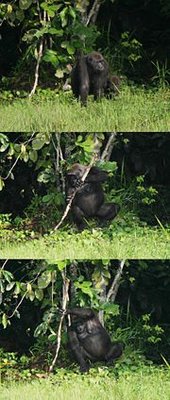 Here is a gorilla seeking out and creating a tool appropriate for her pre-meditated purpose--as a depth gauge for crossing a stream. I found these photos profoundly moving, especially the last one, in which the line between gorillas and humans seems, but for a bit of hair and some skin color, to disappear.
Here is a gorilla seeking out and creating a tool appropriate for her pre-meditated purpose--as a depth gauge for crossing a stream. I found these photos profoundly moving, especially the last one, in which the line between gorillas and humans seems, but for a bit of hair and some skin color, to disappear.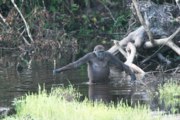






12 comments:
Oh, that last one makes my heart do a zip...we have all done that "ooooo, this water is COLD!" dance!
I found the piece about dusting very interesting. I've noticed birds doing the pulverizing with the beak and wondered what they were doing. Thank you for clarifying.
The picture of the gorilla in the water almost looks like a person crossing a stream.
Sandy A.
I still have brown thrashers in the backyard.....now I'll have to see if I can create a dusting spot they might enjoy using.
Perhaps the young green heron I saw this weekend was dangling a dragonfly to use as bait? You knock my socks of with the knowledge you have and share. I've seen those Thrashers doing their dusting but didn't know what benefits were gained. Wow.
And your vocabulary blew me away tonight but I'm glad I have used the word "whilst" in the correct way. LOL!
You rock, Chimp.
Nice series of the Brown Thrasher dust-bathing.
As for great apes: I'm not surprised by the photos. I have looked gorillas in the eye, and I can attest to the fact that there is someone in there who is not too far removed from me.
~Kathi
This year was the first time I've seen the Brown Thrashers do the "dust bath" in the yard. At first I was unsure what it was doing, but on closer inspection, he was doing exactly as you described. :c) Fascinating stuff.
I've been meaning to dig out that dust bath spot a bit more....
Hey, Julie,
I found this information, from a Harvard scientist (Marc Hauser) interesting as well:
"Differences do arise, however, in how humans use tools as compared to other animals. While animal tools have one function, no other animals combine materials to create a tool with multiple functions. In fact, Hauser says, this ability to combine materials and thought processes is one of the key computations that distinguish human thought.
According to Hauser, animals have “laser beam” intelligence, in which a specific solution is used to solve a specific problem. But these solutions cannot be applied to new situations or to solve different kinds of problem. In contrast, humans have “floodlight” cognition, allowing us to use thought processes in new ways and to apply the solution of one problem to another situation. While animals can transfer across systems, this is only done in a limited way."
There's also the otters that put a big rock on their bellies and break open abalone shells on the rock--all while floating!
I also like the way birds get around the no-opposable-thumbs problem, the way tufted titmice hold a seed in their claws while pecking at it. That's always neat to watch.
There was a show on TV last night and it should orangutans using sticks to get honey out of a hive.
Some times tv can be educational.
Two bad a kant speelnaqd
.
In a zoo I saw a nandu (small type of ostrich) putting a lot of sand on its back while sitting. Do you think to the same purpose?
Marijke
Post a Comment